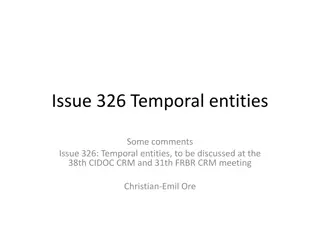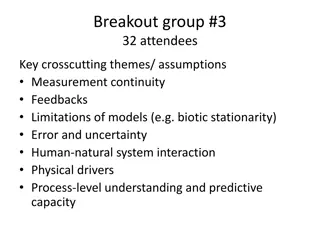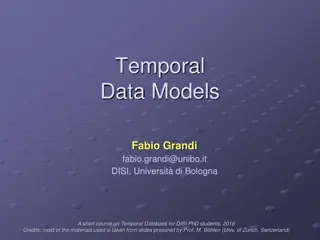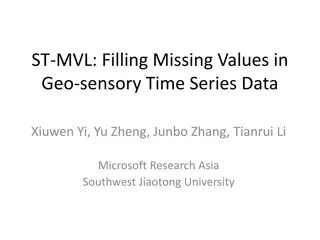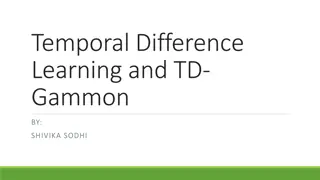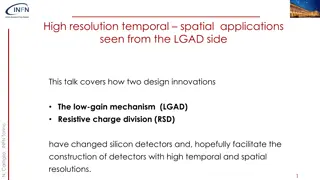Semi-Supervised Credit Card Fraud Detection via Attribute-Driven Graph Representation
Explore a novel approach for detecting credit card fraud using a semi-supervised attribute-driven graph representation. The technique leverages temporal aggregation and attention layers to automatically unify heterogeneous categorical attributes and detect fraudulent transactions without label leaka
1 views • 23 slides
Deep Reinforcement Learning for Mobile App Prediction
This research focuses on a system, known as ATPP, based on deep marked temporal point processes, designed for predicting mobile app usage patterns. By leveraging deep reinforcement learning frameworks and context-aware modules, the system aims to predict the next app a user will open, along with its
0 views • 24 slides
Temporal Data Management in TSQL Queries
Explore the realm of temporal data in TSQL queries, delving into the concepts of valid time and transaction time, different types of relations like snapshot and bi-temporal, and the significance of time dimensions in database management. Learn how temporal databases support time-related queries for
6 views • 41 slides
Localised Adaptive Spatial-Temporal Graph Neural Network
This paper introduces the Localised Adaptive Spatial-Temporal Graph Neural Network model, focusing on the importance of spatial-temporal data modeling in graph structures. The challenges of balancing spatial and temporal dependencies for accurate inference are addressed, along with the use of distri
5 views • 19 slides
The Spatial and Temporal Distribution of Temperature
The spatial and temporal distribution of temperatures plays a crucial role in determining weather patterns, climates, vegetation zones, and wildlife habitats. Factors such as latitude, altitude, distance from the coast, and prevailing winds influence the distribution of temperature both horizontally
3 views • 5 slides
Behavioral Data Analysis During Saccadic Eye Movement Task
Visual systems utilize saccades to focus on objects, impacting temporal perception. This study explores the effects of saccades and stimulus location on perceived time, presenting findings from an experiment on temporal perception mapping with fixed visual duration. The method of psychometric functi
1 views • 12 slides
Discussion on Temporal Entities and Simultaneity in CIDOC CRM Meeting
Temporal entities and the modeling of simultaneity in CIDOC CRM are under discussion at the upcoming meeting. The current approach considers the cardinality of certain relations, aiming to streamline the representation of time-spans and spacetime volumes. The evolving perspectives on the spatial com
3 views • 5 slides
Temporal and Spatial Information Models
This content delves into the intricacies of temporal and spatial information models, covering concepts such as existence, presence, and spatiotemporal relationships. It explores how entities are identified, events are witnessed, and durations are defined within these models. The interplay between ti
5 views • 9 slides
Advanced Concepts in Temporal Point Processes for Human-Centered Machine Learning
Explore advanced concepts in temporal point processes through the lens of human-centered machine learning. Topics include marked temporal point processes, independent identically distributed marks, dependent marks, and mutually exciting marks. Learn about stochastic dynamical systems such as the Sus
0 views • 8 slides
Temporal Coordination of Measurement in Data Centers
Measurement plays a crucial role in data centers for fault diagnosis, traffic engineering, and attack detection. This study focuses on the concept of temporal coordination of measurement to overcome issues like reporting overhead and resource wastage. Various examples illustrate the importance of co
0 views • 29 slides
Paradoxes of Time Travel
Delve into the intriguing concepts surrounding temporal parts, paradoxes of time travel, the relationship between time and change, the impossibility of changing the past, and the arguments presented by David Lewis on the logical constraints of time travel. Discover the complexities of time perceptio
0 views • 33 slides
Epochwise Back Propagation Through Time for Recurrent Networks
In the context of training recurrent networks, Epochwise Back Propagation Through Time involves dividing the data set into independent epochs, each representing a specific temporal pattern of interest. The start time of each epoch, denoted by 'no', is crucial for capturing the sequential dependencie
1 views • 28 slides
Temporal Variability of Ecosystem Processes across Land and Ocean
This content delves into the broad-scale and cross-scale ecosystem processes on land and in the ocean, exploring their temporal variations influenced by underlying structures, biodiversity, and climate. It emphasizes the importance of considering structure, function, and climate response simultaneou
2 views • 9 slides
Examining Reparations for Historic Enslavement: Inter-temporal Challenges
The Law & Race Speaker Series on applying past laws to ongoing wrongs explores the complexities of seeking reparations for historic enslavement. The discussion delves into the inter-temporal considerations, touching on reparation claims by CARICOM, the impact of transatlantic chattel slavery on glob
0 views • 27 slides
Overview of Temporal Data Models and Time Dimensions in Databases
Explore the concepts of temporal data models and time dimensions in databases, covering topics such as data structures, query languages, different timestamp types, valid time, and transaction time. Learn about the importance of supporting various time aspects in database systems and the complexities
1 views • 52 slides
Handling Label Noise in Semi-Supervised Temporal Action Localization
The Abstract Semi-Supervised Temporal Action Localization (SS-TAL) framework aims to enhance the generalization capability of action detectors using large-scale unlabeled videos. Despite recent progress, a significant challenge persists due to noisy pseudo-labels hindering efficient learning from ab
0 views • 30 slides
Spacetime Volume and Temporal Information
Explore the definitions, relationships, and properties of spacetime volume, temporal information, and their components like time spans and entities. Learn about how events are witnessed and defined within specific spatiotemporal contexts.
0 views • 9 slides
Flexible Spatio-temporal Indexing Scheme for Large Scale GPS Tracks Retrieval
This research paper discusses a novel spatio-temporal indexing scheme optimized for managing large-scale GPS data. The study introduces a stochastic process model to simulate user behavior in uploading GPS tracks, leading to a more efficient indexing scheme with smaller size, minimal update efforts,
0 views • 24 slides
Enhancing Long-Term Energy Models for Variable Renewables
Explore approaches to enhance long-term energy models for integrating variable renewables in long-term planning. Key aspects include improving generation networks, ensuring sufficient capacity and reliability, flexibility, robustness to contingencies, and security considerations. Temporal matching o
2 views • 22 slides
Filling Missing Values in Geo-Sensory Time Series Data
Filling missing values in spatio-temporal data is crucial for accurate analysis. This research focuses on inferring missing entries using collective information from sensors and neighborhoods. It addresses challenges like random and block missing data, non-linear variations in readings over time and
0 views • 10 slides
Temporal Quality Assessment for Mobile Videos
This research focuses on developing a novel Temporal Variation Metric (TVM) to assess the temporal quality of mobile videos. The approach aims to accurately measure temporal information without the need for optical flow methods, making it suitable for embedded devices. The methodology, including the
0 views • 20 slides
Probabilistic Database Model
This research explores the development of a temporal-probabilistic database model to handle uncertain temporal facts obtained from information extraction methods. Motivated by the need for scalable query engines and a lack of unified approaches supporting both time and probability aspects, the study
0 views • 21 slides
Temporal Graph Analysis for Real-world Graph Evolution
Chronos: A Graph Engine for Temporal Graph Analysis in a social graph environment from years 2012 to 2014. Uncover insights through temporal graph properties and user ranking variations across different years. Discover the evolution of real-world graphs and the computation of properties on graph sna
0 views • 43 slides
Digital Twin Navigator: Temporal Scales and Strategy
A Digital Twin offers a wide spectrum of possibilities, with varying temporal scales and strategic implications. Learn how different temporal scales influence decision-making and see a practical example of a digital twin strategy for a new hospital building. Discover the sophistication levels and ke
0 views • 11 slides
Extracting Dense Regions from Hurricane Trajectory Data
This research paper discusses the extraction of dense regions from hurricane trajectory data using spatio-temporal analysis techniques. The study explores the application of DBSCAN algorithm and temporal extension for clustering hurricane data based on spatial and non-spatial attributes. Experimenta
1 views • 21 slides
Mastering Spatial and Temporal Evaluation in A-Level Geography
Enhance your spatial and temporal evaluation skills as an A-Level geographer by delving into the importance of evaluating space and time, particularly within the context of the Australia Wildfires 2019. Understand spatial analysis, impact significance, and temporal evaluation scales to deepen your c
0 views • 13 slides
Spatio-Temporal Analytics and Data Management Strategies
Explore the world of extreme-scale analytics on spatio-temporal datasets, morphometric image analysis pipeline, satellite data analysis, and subsurface reservoir management. Gain insights into core operation categories, data access patterns, computational complexity, and more for efficient data hand
0 views • 10 slides
Contrastive Regression Transformer for Skill Assessment in Robotic Surgery
Explore the innovative Contrastive Regression Transformer model, Contra-Sformer, tailored for skill assessment in robotic surgery. This model focuses on expressing the similarity levels between surgical executions, enabling precise evaluation based on spatio-temporal deviations from a reference. Lev
0 views • 24 slides
Kookmin PHY Sub-Proposal for ISC Using Temporal Scheme
Explore Kookmin University's PHY sub-proposal for ISC with a focus on temporal scheme (C-OOK) modulation for rolling shutter camera receivers. The proposal discusses design considerations, system architecture, data packet structures, asynchronous decoding, and packet recovery methods. Learn about va
0 views • 33 slides
Analyzing Transportation Data for Temporal Instability Trends
Explore the impact of temporal instability on transportation data analysis, focusing on models of human behavior, safety analytics, evolution of behavior in highway accidents, and upcoming safety technologies like autonomous vehicles. Delve into historical accident data analysis and the challenges o
0 views • 40 slides
Understanding Formal Systems and Temporal Logic for System Design
Explore the fundamentals of temporal operators, logic, and transition systems in formal system design, with a focus on the importance of temporal logic and its application in implementing logical specifications. Dive into the world of assertion IPs, temporal properties, and Kripke structures for a d
0 views • 88 slides
Temporal Difference Learning and TD-Gammon: Advancements in Reinforcement Learning
Explore TD-Gammon, a neural network that learns backgammon by self-play, uncovering novel approaches in reinforcement learning. Understand the benefits of reinforcement learning, challenges like temporal credit assignment, and advancements in nonlinear function approximation methods like Temporal Di
0 views • 27 slides
Temporal Relations Annotation Scheme for Event Understanding
Explore a multi-axis annotation scheme for event temporal relations, addressing challenges of low inter-annotator agreement and time-consuming processes. The approach redefines the task to enhance accuracy and efficiency in temporal relation extraction.
0 views • 23 slides
Understanding Joint Reasoning for Temporal and Causal Relations
Explore the importance of understanding temporal and causal relations in events, leveraging examples to illustrate how temporal and causal determinations are interconnected. Discover how time-sensitive information aids in establishing relationships between events, enhancing comprehension through joi
0 views • 22 slides
Understanding High-Resolution Temporal Spatial Applications with LGAD
Delve into the innovative design concepts like LGAD and RSD transforming silicon detectors for enhanced temporal and spatial resolutions. Explore the advancements made by INFN Torino in silicon sensor technology for improved tracking capabilities, utilizing LGAD-based detectors and FAST ASICs. Uncov
0 views • 37 slides
Optimizing Network Performance with Hyperparameters and Temporal Features
Explore the intricate world of hyperparameter optimization, combining temporal and non-temporal features in network construction. Dive into learning rates, optimizers, network architecture, activation functions, and more for building your first efficient network. Get ready to train a network and sub
0 views • 5 slides
Bayesian Analysis of Spatio-Temporal Dynamic Panel Models
Explore the Bayesian analysis of spatio-temporal dynamic panel models with fixed and random effects. Learn about the spatial and temporal correlation in data and the estimation of covariance functions. See how these models are applied to analyze economic factors affecting crime data in Tehran city.
0 views • 32 slides
Coherent Probabilistic Forecasting for Temporal Hierarchies Presentation by Syama Rangapuram
Explore the framework for coherent probabilistic forecasting in temporal hierarchies presented by Syama Rangapuram. Discover how this end-to-end approach enhances forecasts across various temporal granularities, guaranteeing non-negativity and reducing model variance.
0 views • 8 slides
Understanding the Anatomy of Temporal Bone: Dr. Rahul Bagla's Insights
Explore the intricate details of human temporal bone anatomy as explained by Dr. Rahul Bagla, a renowned authority in the field. Learn about the structure, relations, and parts of the temporal bone, including the squamous part and its crucial connections to surrounding bones. Enhance your knowledge
0 views • 22 slides
Understanding Temporal Databases and Their Applications
Explore the significance of temporal databases, their applications in various sectors like healthcare and finance, and the limitations of traditional databases in managing temporal data effectively. Learn how developers can overcome these challenges to enhance data organization efficiently.
0 views • 69 slides






